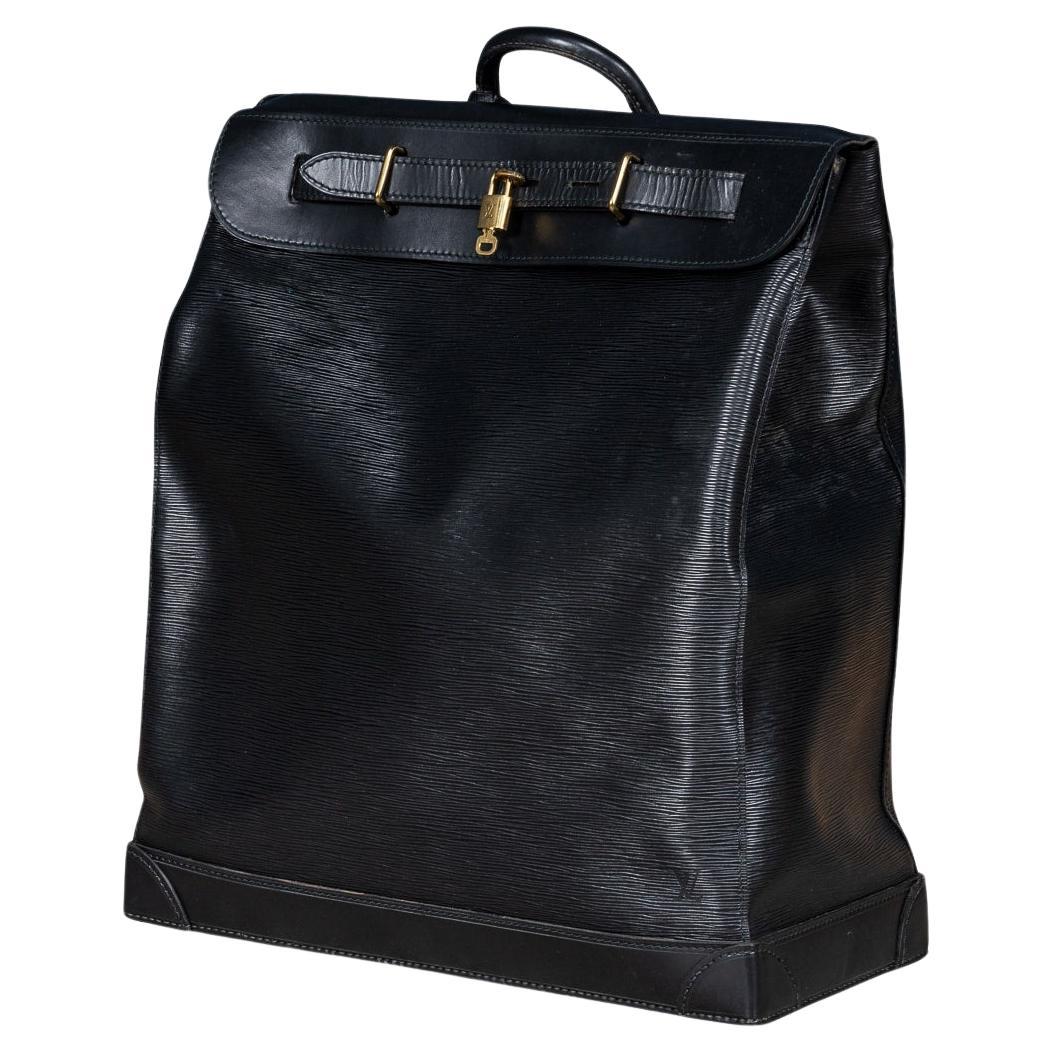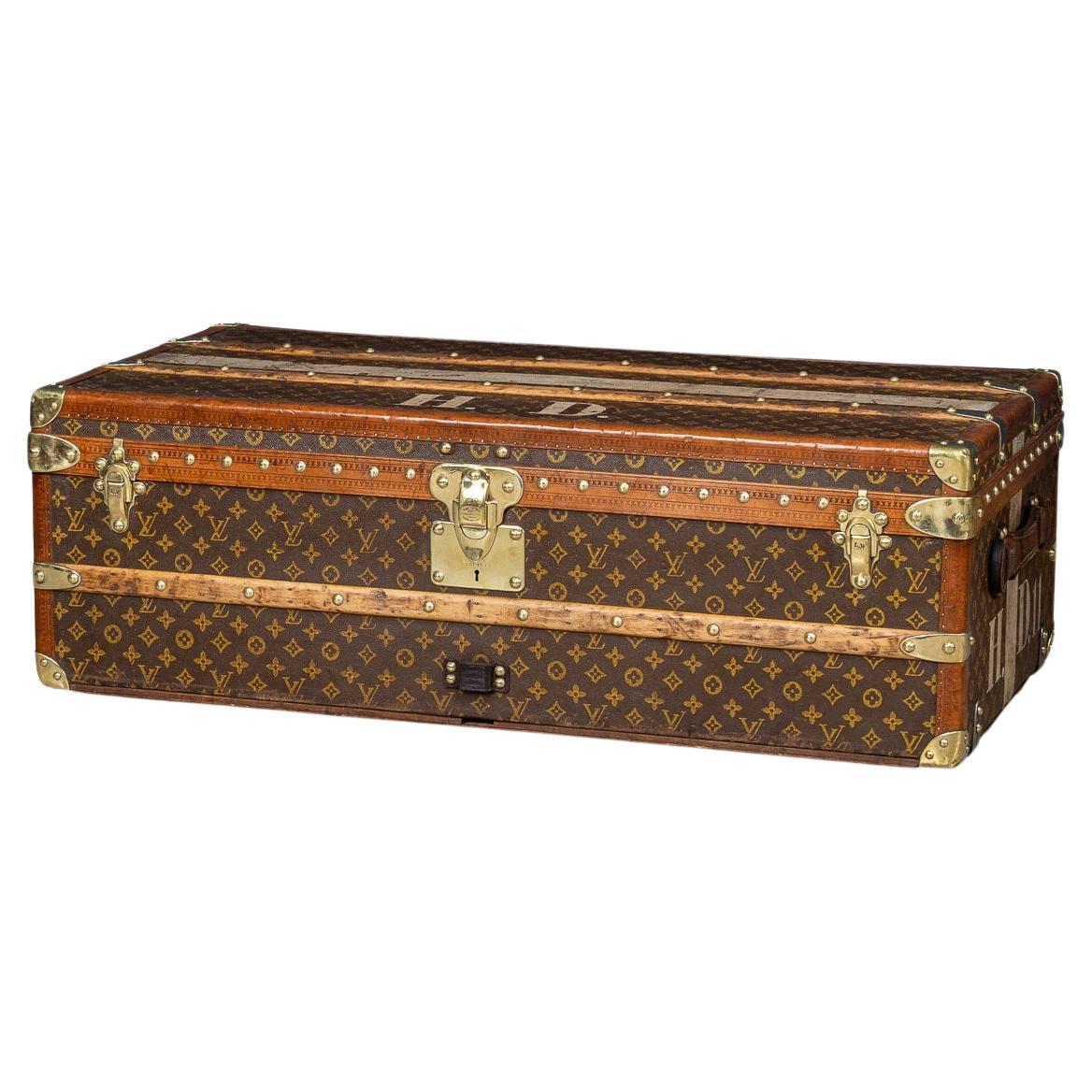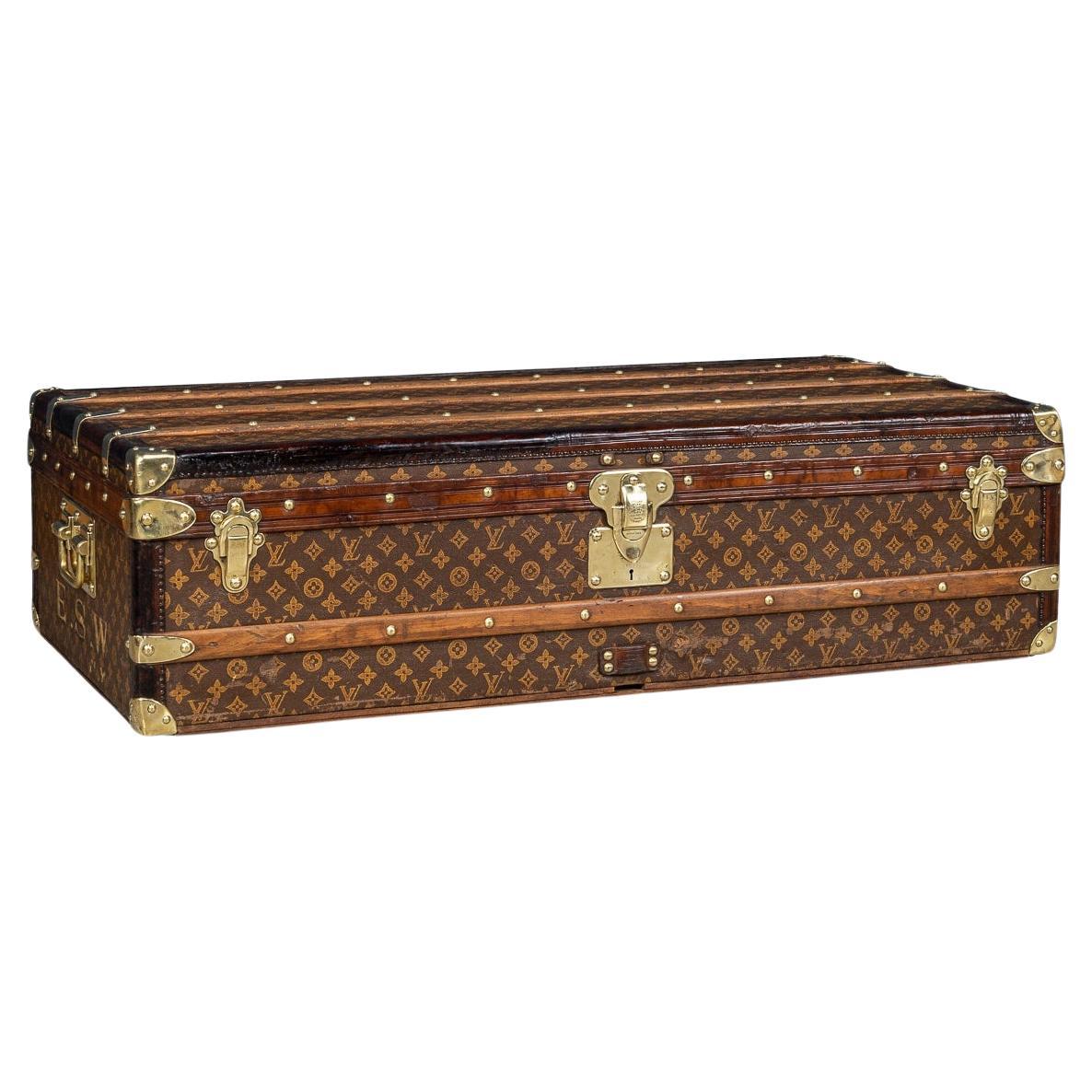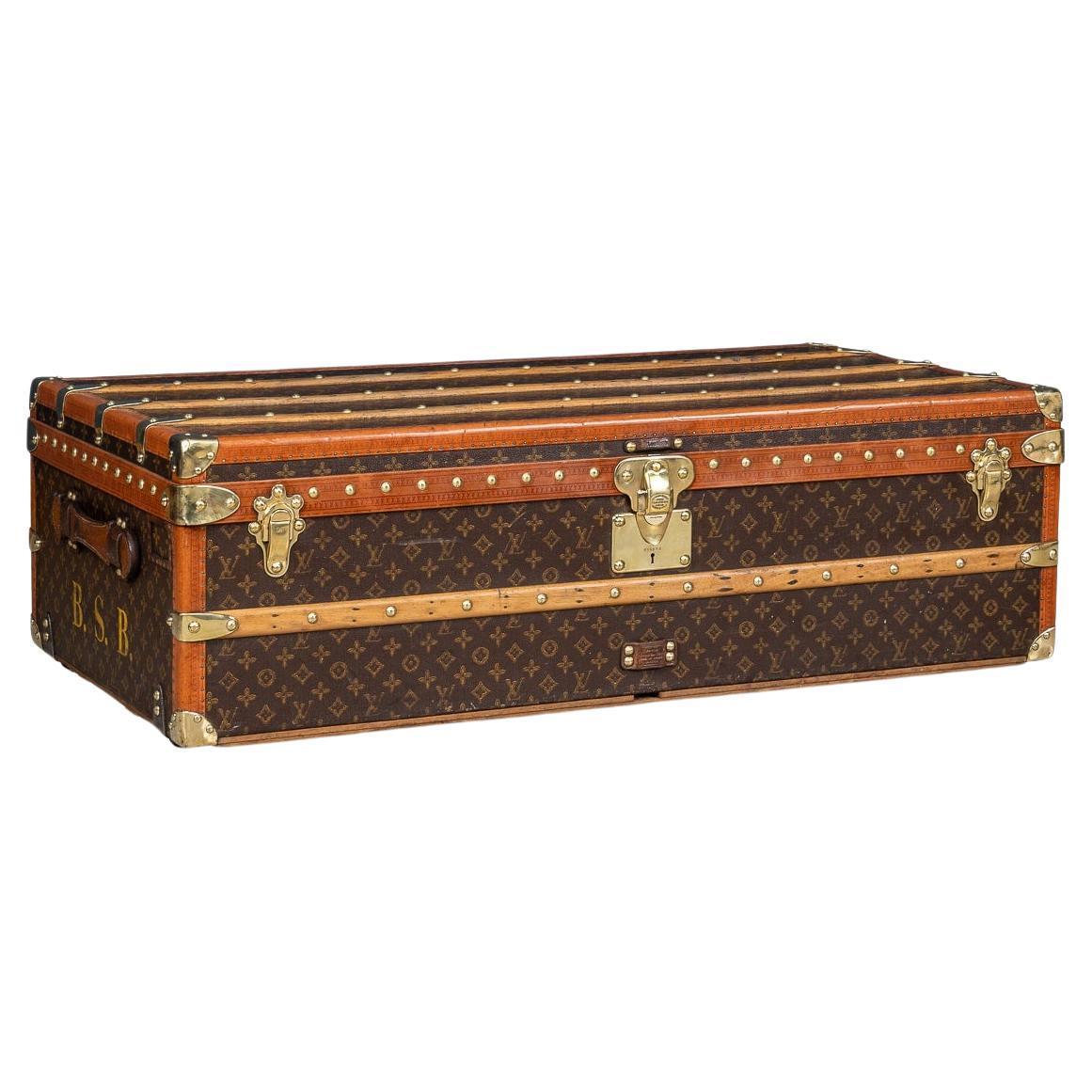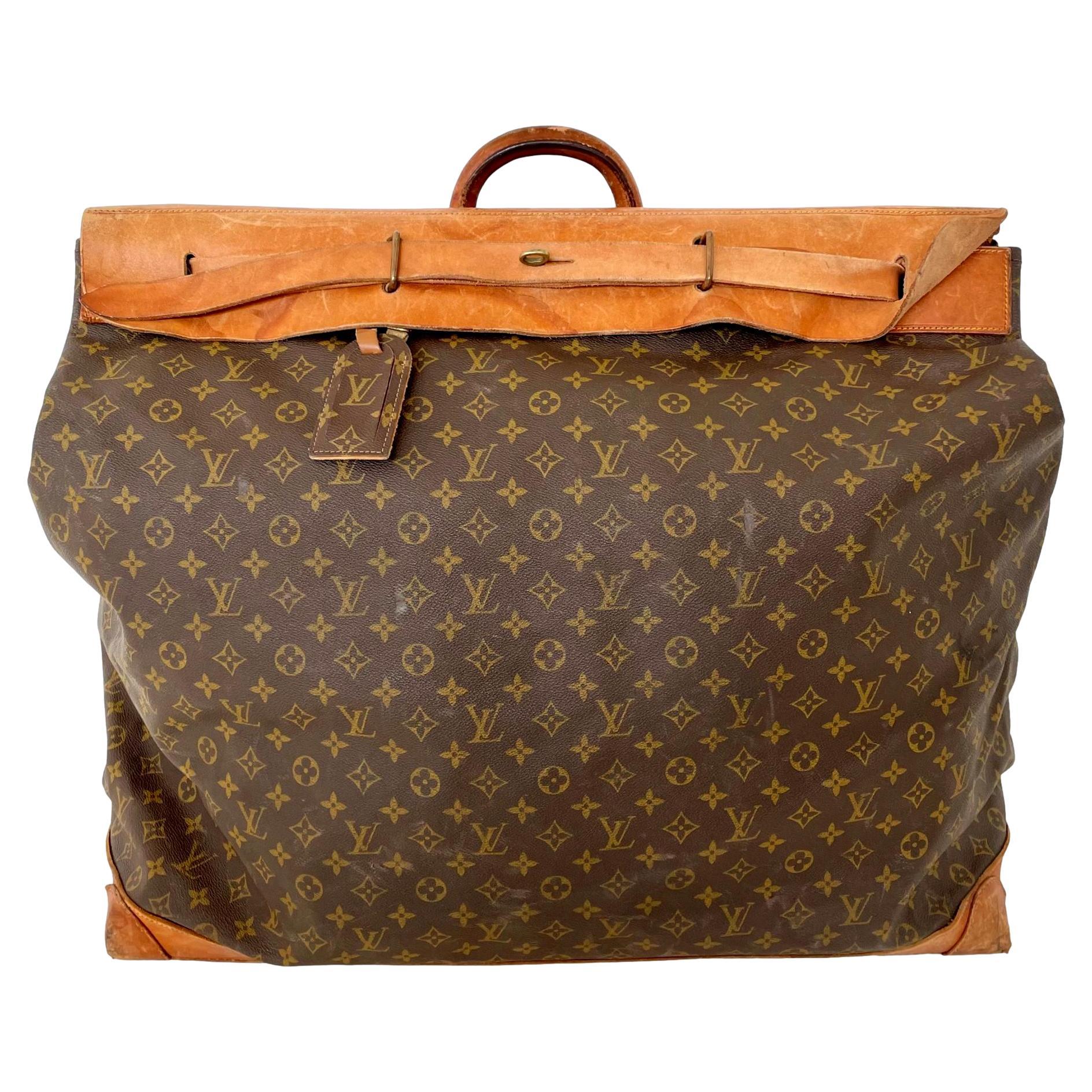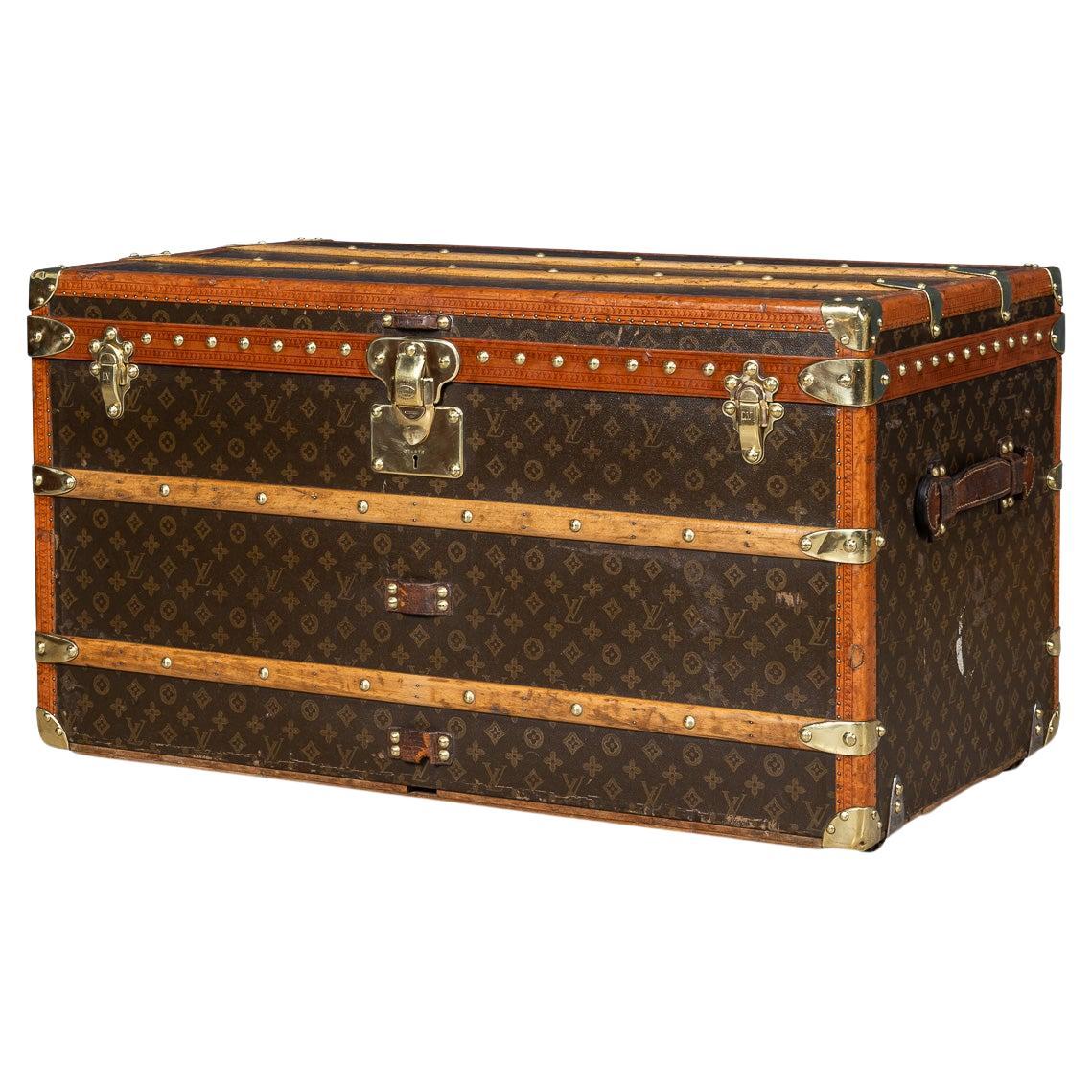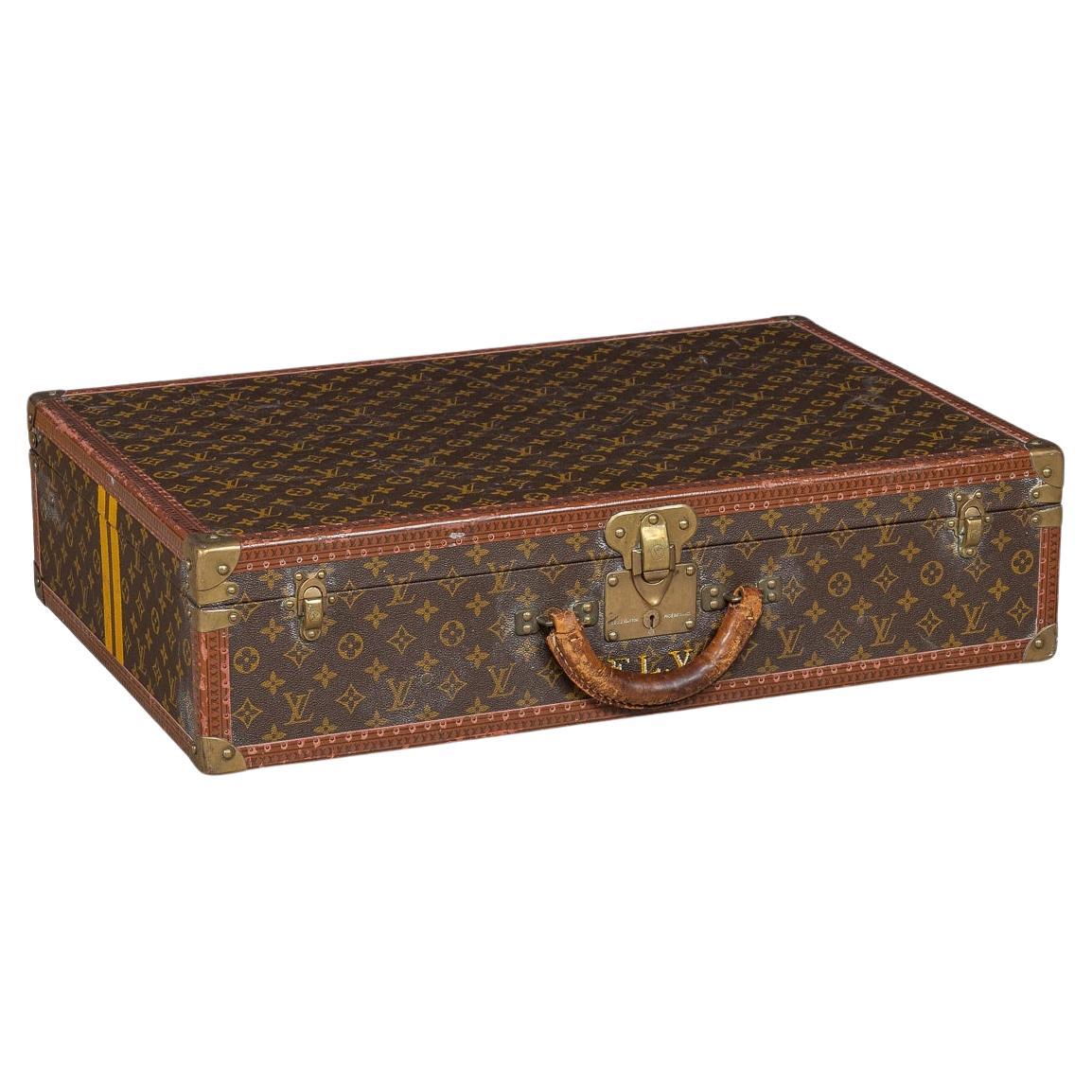
20th Century Louis Vuitton Steamer Bag, Made In France
View Similar Items
20th Century Louis Vuitton Steamer Bag, Made In France
About the Item
- Creator:Louis Vuitton (Maker)
- Dimensions:Height: 25.2 in (64 cm)Width: 21.66 in (55 cm)Depth: 10.63 in (27 cm)
- Materials and Techniques:
- Place of Origin:
- Period:
- Date of Manufacture:circa 1980
- Condition:Wear consistent with age and use. Minor fading. In Good Overall Condition - Some signs of darkening to the leather at the bottom as can be expected with moderate to light use and general wear. Please refer to photographs.
- Seller Location:Royal Tunbridge Wells, GB
- Reference Number:Seller: B9386d1stDibs: LU1348235831562
Louis Vuitton
The story behind iconic luxury brand Louis Vuitton — best known for its esteemed handbags, crossbody bags, leather goods, ready-to-wear clothing and more — is one of craft and innovation in the worlds of fashion, jewelry and furniture.
The company’s modest origins can be traced back to when its founder, Louis Vuitton (1821–92), wishing to free himself from the conventional lifestyle in his provincial French city of Anchay as well as a difficult stepmother, left in the early 1830s to make a new life in Paris. The young Vuitton was 13 at the time and would need to travel on foot to get to the capital, which was hundreds of miles away. With stops along the way to make money so that he could forge ahead, the journey took a couple of years, but reward was close at hand.
When he arrived in Paris, Vuitton made a living with his hands. He toiled as a box maker and packer for more than a decade and built relationships with royals and members of the upper class while working for the empress of France, Eugenie de Montijo. In 1854, Vuitton launched his namesake company. The craftsman opened a humble workshop on rue Neuve des Capucines and advertised his services with a small poster that read: “Securely packs the most fragile objects. Specializing in packing fashions.”
Long before his brand would become known globally for its exemplary top-handle bags and stylish totes, Vuitton produced stackable and rectangular trunks. The most common trunks of the era were round, which weren’t ideal for toting and storing. In 1858, Vuitton debuted his lightweight, handcrafted canvas trunks, which were sturdy, rugged and equipped with convenient compartments. Travel’s popularity broadened in the late 19th century, and Vuitton’s trunks could easily be packed into train cars and ships — upright trunks meant hanging wardrobe storage that would allow his clients to transport their sophisticated garments without worry. Demand increased and the company grew. When Louis Vuitton died in 1892, control of the luxury house was passed onto his only son, Georges Vuitton.
In 1914, a Louis Vuitton store opened at 70 Champs-Élysées. The largest travel-goods store in the world at the time, it became the company’s flagship.
The Louis Vuitton brand embodies all the attributes of luxury, from the craftsmanship, exclusivity and relevance to heritage. It’s only appropriate that it boasts one of the most recognizable insignias — the imaginative interlocking of letters and fleurettes — in the fashion world. The famous LV monogram was first used in 1896 as part of an initiative by Georges to prevent counterfeiting of his coveted new line of travel trunks. It’s one of the earliest examples of fashion branding.
The LV monogram would soon appear on everything from bags and various fashion accessories to alligator-skin champagne cases, from stylish apparel and earrings to teddy bears and airplane models.
On 1stDibs, the unmistakable insignia can be found on both modern and vintage Louis Vuitton shoulder bags, suitcases, original 19th-century trunks, jackets and more.
- 20th Century Louis Vuitton Steamer Bag In Monogram Canvas, Made In FranceBy Louis VuittonLocated in Royal Tunbridge Wells, KentA 20th Century Louis Vuitton steamer travel bag, crafted from monogram canvas and natural tan leather, serves as a quintessential representation of the brand's unwavering commitment to a design seamlessly harmonising style and utility. Inspired by the practical proportions of mailbags from the Americas, these bags effortlessly combine chic aesthetics with practical functionality—whether hung on a cabin door, displayed on a deck, or utilised for a spontaneous weekend getaway. The monogram canvas, adorned with iconic LV initials and floral motifs, stands out not only for its recognisability but also for its exceptional durability. Teamed with natural tan leather, this pairing gracefully matures, developing a lavish patina over time that enhances the bag's inherent character. The enduring design underscores Louis Vuitton's timeless allure, elevating these pieces to coveted collector's items that encapsulate the brand's storied history and commitment to impeccable craftsmanship. A brief history about Louis Vuitton trunks: Louis Vuitton was born in 1821 to a farmer and milliner and came from a long-established working-class family in eastern France. Vuitton grew up understanding the effects of perseverance and a strong work ethic from watching his family. At the age of 16, he made the decision to walk 292 miles from his hometown to Paris to try and make a new life for himself. When he arrived the city was in the midst of industrialisation with current modes of transportation evolving quickly allowing for longer journeys. With this came the need for sturdy travel pieces. Vuitton was taken as an apprentice for a successful box maker and packer named Monsieur Marechal. He learned to craft durable containers and how to pack them properly – a well-respected profession at the time.In 1854, years after he had mastered his craft and became well respected for it, Vuitton ventured out on his own to open a shop on Rue Neuve des Capucines. It was here that he began to establish himself as a luggage maker. Then, in 1858, Vuitton designed the first Louis Vuitton steamer trunk. At the time trunks had rounded tops to allow for water to run off but this did not allow for convenient stowage. Vuitton introduced a flat, yet waterproof, trunk that was easily stackable. The first of his trunks were outfitted with a grey canvas referred to as Trianon – it wouldn’t be until several decades later that the signature monogram would be introduced. With a burgeoning business, Vuitton moved his family and workplace to Asniere, where he employed twenty workers to craft his trunks. By 1900 he would have 100 employees, and in 1914 the company would more than double in size. After years of success, Vuitton began to experiment with the design of his luggage by introducing a new striped canvas pattern (1876) and later the still well-known Damier print (1888). The hand-painted patterns were developed to prevent counterfeits. Even in the late 1800s, Louis Vuitton was enough of a status symbol to warrant counterfeiting. In 1886, his son George invented and patented an ingenious locking system that made it impossible to pick the lock of their trunks. This lock is still used today. 1892 would prove to be a time of mourning for the family as Louis Vuitton passed...Category
20th Century French Other Trunks and Luggage
MaterialsBrass
- 20th Century Louis Vuitton Steamer Bag In Monogram Canvas, Made In FranceBy Louis VuittonLocated in Royal Tunbridge Wells, KentA lovely Louis Vuitton steamer travel bag in monogram canvas and natural tan leather, made in France in the latter quarter of the 20th century. Steamer bags have been produced by Lou...Category
Vintage 1980s French Other Trunks and Luggage
MaterialsLeather, Cane
- 20th Century Louis Vuitton Steamer Bag In Epi Leather Canvas, Made In FranceBy Louis VuittonLocated in Royal Tunbridge Wells, KentA large Louis Vuitton steamer travel bag in Epi leather, made in France in the latter quarter of the 20th century. Steamer bags have been produced by Louis Vuitton for over 120 years...Category
Vintage 1980s French Trunks and Luggage
MaterialsLeather
- 20th Century Louis Vuitton Steamer Bag In Epi Leather Canvas, Made In FranceBy Louis VuittonLocated in Royal Tunbridge Wells, KentA large Louis Vuitton steamer travel bag in black Epi leather, made in France in the latter quarter of the 20th century. Steamer bags have been produced by Louis Vuitton for over 120...Category
20th Century French Other Trunks and Luggage
MaterialsBrass
- 20th Century Louis Vuitton Trunk, France c.1930By Louis VuittonLocated in Royal Tunbridge Wells, KentAn exquisite and complete Louis Vuitton trunk from the early part of the 20th century. An absolutely essential item for elite travellers of its time the trunk is adorned in the iconic LV monogrammed canvas, accented by lozine trim and brass fittings. This trunk stood as the epitome of luxury over 100 years ago, boasting an unparalleled level of sophistication and elegance, it remains a timeless masterpiece that transcends eras. The captivating allure of the Louis Vuitton trunk transforms it into more than a mere luggage accessory; it becomes a focal point for any room. With its impressive dimensions, it is perfectly suited as a striking coffee table, side table, or even as a standalone centrepiece, seamlessly integrating into any interior, whether modern or traditional. An extraordinary piece that not only pays homage to the past but also serves as a statement of unparalleled luxury in the present. A brief history about Louis Vuitton trunks: Louis Vuitton was born in 1821 to a farmer and milliner and came from a long-established working-class family in eastern France. Vuitton grew up understanding the effects of perseverance and a strong work ethic from watching his family. At the age of 16, he made the decision to walk 292 miles from his hometown to Paris to try and make a new life for himself. When he arrived the city was in the midst of industrialization with current modes of transportation evolving quickly allowing for longer journeys. With this came the need for sturdy travel pieces. Vuitton was taken as an apprentice for a successful box maker and packer named Monsieur Marechal. He learned to craft durable containers and how to pack them properly – a well-respected profession at the time.In 1854, years after he had mastered his craft and became well respected for it, Vuitton ventured out on his own to open a shop on Rue Neuve des Capucines. It was here that he began to establish himself as a luggage maker. Then, in 1858, Vuitton designed the first Louis Vuitton steamer trunk. At the time trunks had rounded tops to allow for water to run off but this did not allow for convenient stowage. Vuitton introduced a flat, yet waterproof, trunk that was easily stackable. The first of his trunks were outfitted with a grey canvas referred to as Trianon – it wouldn’t be until several decades later that the signature monogram would be introduced. With a burgeoning business, Vuitton moved his family and workplace to Asniere, where he employed twenty workers to craft his trunks. By 1900 he would have 100 employees, and in 1914 the company would more than double in size. After years of success, Vuitton began to experiment with the design of his luggage by introducing a new striped canvas pattern (1876) and later the still well-known Damier print (1888). The hand-painted patterns were developed to prevent counterfeits. Even in the late 1800s, Louis Vuitton was enough of a status symbol to warrant counterfeiting. In 1886, his son George invented and patented an ingenious locking system that made it impossible to pick the lock of their trunks. This lock is still used today. 1892 would prove to be a time of mourning for the family as Louis Vuitton passed...Category
20th Century French Other Trunks and Luggage
MaterialsBrass
- 20th Century Louis Vuitton Trunk, France c.1910By Louis VuittonLocated in Royal Tunbridge Wells, KentAn exquisite and complete Louis Vuitton trunk from the early part of the 20th century. An absolutely essential item for elite travellers of its time the trunk is adorned in the iconic LV monogrammed canvas, accented by lozine trim and brass fittings. This trunk stood as the epitome of luxury over 100 years ago, boasting an unparalleled level of sophistication and elegance, it remains a timeless masterpiece that transcends eras. The captivating allure of the Louis Vuitton trunk transforms it into more than a mere luggage accessory; it becomes a focal point for any room. With its impressive dimensions, it is perfectly suited as a striking coffee table, side table, or even as a standalone centrepiece, seamlessly integrating into any interior, whether modern or traditional. An extraordinary piece that not only pays homage to the past but also serves as a statement of unparalleled luxury in the present. A brief history about Louis Vuitton trunks: Louis Vuitton was born in 1821 to a farmer and milliner and came from a long-established working-class family in eastern France. Vuitton grew up understanding the effects of perseverance and a strong work ethic from watching his family. At the age of 16, he made the decision to walk 292 miles from his hometown to Paris to try and make a new life for himself. When he arrived the city was in the midst of industrialization with current modes of transportation evolving quickly allowing for longer journeys. With this came the need for sturdy travel pieces. Vuitton was taken as an apprentice for a successful box maker and packer named Monsieur Marechal. He learned to craft durable containers and how to pack them properly – a well-respected profession at the time.In 1854, years after he had mastered his craft and became well respected for it, Vuitton ventured out on his own to open a shop on Rue Neuve des Capucines. It was here that he began to establish himself as a luggage maker. Then, in 1858, Vuitton designed the first Louis Vuitton steamer trunk. At the time trunks had rounded tops to allow for water to run off but this did not allow for convenient stowage. Vuitton introduced a flat, yet waterproof, trunk that was easily stackable. The first of his trunks were outfitted with a grey canvas referred to as Trianon – it wouldn’t be until several decades later that the signature monogram would be introduced. With a burgeoning business, Vuitton moved his family and workplace to Asniere, where he employed twenty workers to craft his trunks. By 1900 he would have 100 employees, and in 1914 the company would more than double in size. After years of success, Vuitton began to experiment with the design of his luggage by introducing a new striped canvas pattern (1876) and later the still well-known Damier print (1888). The hand-painted patterns were developed to prevent counterfeits. Even in the late 1800s, Louis Vuitton was enough of a status symbol to warrant counterfeiting. In 1886, his son George invented and patented an ingenious locking system that made it impossible to pick the lock of their trunks. This lock is still used today. 1892 would prove to be a time of mourning for the family as Louis Vuitton passed...Category
20th Century French Other Trunks and Luggage
MaterialsBrass
- Louis Vuitton Steamer Trunk, Early 20th C.Located in New York, NYLouis Vuitton Steamer Trunk, Early 20th Century, in LV monogrammed pattern with metal side handles and fittings, decoupaged stickers to all fours sides and top, lock inscribed "BTE S.G.D.G. PATENT/ 1 RUE SCRIBE...Category
Early 20th Century French French Provincial Trunks and Luggage
MaterialsMetal
- Vintage Louis Vuitton Steamer BagBy Louis VuittonLocated in Los Angeles, CAClassic vintage Louis Vuitton steamer bag. Large, oversized bag, perfect for weekend trips. LV monogram print with saddle leather and bra...Category
Vintage 1970s French Trunks and Luggage
MaterialsBrass
$11,500 / item - 20th Century Louis Vuitton Keepall Bag Classic Monogram Canvas '80sBy Louis VuittonLocated in Turin, TurinAn icon since 1930, the Keepall represents the spirit of the modern traveler. Lightweight, soft, and always ready for an impromptu departure, the bag lives up to its name. Timeless K...Category
Vintage 1980s French Modern Trunks and Luggage
MaterialsLeather
- 20th Century Louis Vuitton Garment Bag Classic Monogram Canvas 80sBy Louis VuittonLocated in Turin, TurinThe Garment Cover by Louis Vuitton from the 80s is fashioned from Monogram canvas with a well-designed construction to insure a comfortable carry, even wit...Category
Vintage 1980s French Modern Trunks and Luggage
MaterialsLeather
- Louis Vuitton Malle Cabine Monogram trunk France 20th century circa 1930By Louis VuittonLocated in Pambio Noranco, CHLouis Vuitton's elegant and exclusive Malle Cabine trunk, the Maison's travel icon. The sophisticated creation, with its compact design, was intended to be stowed under the cabin bed...Category
Early 20th Century French Trunks and Luggage
MaterialsBrass
- Louis Vuitton Malle Cabine Damier trunk France 20th century circa 1890By Louis VuittonLocated in Pambio Noranco, CHLouis Vuitton's elegant and exclusive Malle Cabine trunk, the Maison's travel icon. The sophisticated creation, with its compact design, was intended to be stowed under the cabin bed...Category
Late 20th Century French Trunks and Luggage
MaterialsBrass
Recently Viewed
View AllRead More
How to Spot a Fake Louis Vuitton
What are the telltale signs that you're holding a real Louis Vuitton and not a knockoff? We spoke with expert Diane D’Amato to find out. Of course, you don't have to worry about fakes on 1stDibs, where every seller is highly vetted.
Inside Louis Vuitton’s Most Popular Handbag Collaborations
The venerable brand has earned accolades (and gained new fans) for partnerships that meld fashion with art.



